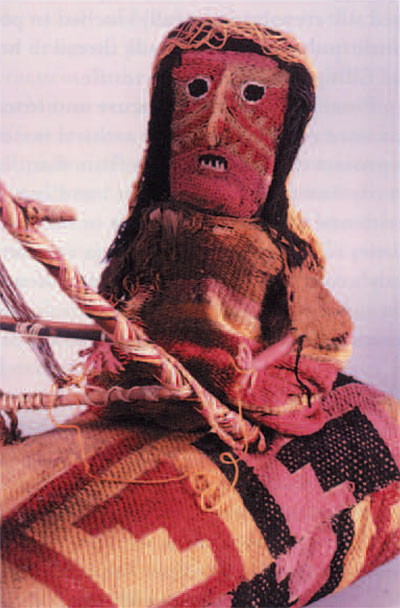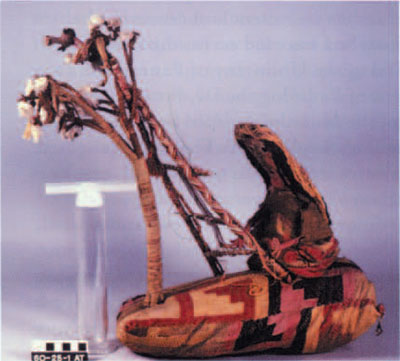
In the early 1960s the University of Pennsylvania Museum acquired an unusually precolumbian figural object. It consists of a doll-like female working at an A-frame loom which is supported by a tree replete with woven leaves and seed pods, tassel blossoms, and a basketry nest with a rather whimsical resident bird. This composition sits upon a woven textile pillow base stuffed with dried leaves. The object lacks a definite provenience, but through comparison with similar effigies and textiles in Peruvian collections it was determined to be from the Chancay Valley, north of present-day Lima, and to date to the Late Chancay period (Kidder 1963), or approximately 1000-1476 CE. The good preservation of this delicate construction is almost certainly a result of its being entombed in this coastal desert region of Peru, which has one of the driest climates on earth.
This is how I came to make her acquaintance, as a student intern from the Winterthur/University of Delaware Program in Art Conservation. The Weaving Lady was rather gleefully proffered as a likely project by Senior Conservator Virginia Greene and Conservator Lynn Grant. I looked nervously at the figure with 500 to 1000-yearold brittle fibers, torn seams. unraveling weaves, loosely dangling elements, and probable untold other complications…but also with an irresistible personality. So the project was accepted and examination of the Weaving Lady’s condition was begun.
After her probable origins were settled, the Weaving Lady, as she was informally known, was placed on exhibition in the Museum’s galleries where she remained for the next thirty or so years. Three decades in Philadelphia’s decidedly undesert-like climate took its toll, and the now slumping Lady with her drooping bird and tree branches was retired to a cabinet in the Conservation Laboratory. (I suspect that every conservation lab has one of these repositories of objects awaiting some elusive slack time or the appearance of a graduate student intern.)
At some point in the modern life of the Weaving Lady, or maybe over several years, she had been subjected to some well-meaning, but ultimately ill-advised repairs. Many were likely to have been done before acquisition by the Museum to make the object as presentable, and perhaps as saleable, as possible. The tree branches and bird had been tied in various ways and now-corroded straight pins had been added to hold branches and loom components together. A seam repair in the pillow was placing great stress on the fragile fibers, as were modern threads tying tree and figure to the pillow. It was obvious that a large part of the conservation treatment, as is often the case, would be the removal of the modern repair materials.
To aid in her treatment and recovery, the Weaving Lady was escorted across the street to the Hospital of the University of Pennsylvania’s Department of Radiology by Dr. Stuart Fleming, Director of the Museum Applied Science Center for Archaeology, and myself. There the delighted and cooperative technicians took x-radiographs of her interior. The images revealed approximately sixty more pins than had been anticipated, along with various lengths of wire and a most unusual structural support—an 8-inch-long hatpin with an enameled maple-leaf head. This was stuck vertically through the entire figure, apparently to keep the head upright. The x-radiographs were used as maps to locate all the pins and wires for extraction, as the corrosion of these posed a potential chemical and physical threat to the delicate yarn fibers and substrates.

These unwanted metal components could readily be identified as 20th century additions, but it was more difficult to identify modern threads. Before any of the tangle of supposed modern repair threads was cut away, fibers were examined microscopically to distinguish contemporary additions from original material. The ancient fibers were of two basic types: animal from the llama family (with structures consistent with those of the guanaco and alpaca) and cotton—expected types for precolumbian Peru. Fibers suspected to be modern were also cotton, but with a fortunate difference. The image under the microscope lens presented the smooth straight ribbon-like appearance of mercerized cotton, as opposed to the more convoluted lengths of handspun cotton fiber. So all mercerized cotton repairs could be carefully disentangled from the Lady.
The pin extraction operation and removal of stitches left the figure. tree limbs, and bird in even more compromising positions. To remedy this, a judicious number of stainless steel insect pins and rod were used to reinforce the tree. Loose leaves were sewn back onto their twigs with fine silk thread and the bird was sewn more securely to the nest. Seemingly countless unraveling ends of yarn in the tree and on the loom were stuck back down with wheat starch paste and the torn gap in the side of the pillow was unobtrusively patched with gauzy dyed silk crepeline carefully stitched in place with cotton/polyester and fine silk thread to hold in the leaf filling and stabilize the textile.
Finally, a support armature and storage box were constructed from archival materials to protect the Weaving Lady from dust, light. gravity-induced strain, direct handling, and accidental mechanical damage in the storage facilities. This last step will help to ensure the Lady’s continued long life at the Museum, where I’m sure she will continue to captivate those fortunate enough to make her acquaintance.
Julia Lawson
Assistant Objects Conservator, Conservation Department
